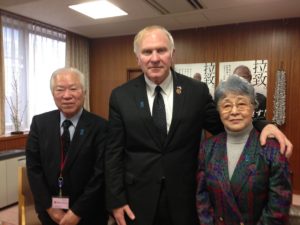In my capacity as Chairman of the Foreign Affairs Subcommittee on Asia and the Pacific, I’m perhaps not surprisingly, in Asia and the Pacific. Congress is not in session this week, and I am accompanying a bipartisan Congressional Delegation of five Republican and three Democratic Members of Congress: Brad Sherman of California, Madeleine Bordallo of American Guam, and Joseph Kennedy of Massachusetts (the three Democrats); Ed Royce of California, Joe Wilson of South Carolina, Luke Messer of Indiana, Randy Weber of Texas, and myself (the Republicans.)
I’ll address a few of the issues the United States is facing with each of the five nations we are visiting, in the order that we’re visiting them.
First, Japan. The relationship between the United States and Japan is the cornerstone of our involvement in Southeast Asia. This is particularly the case as a result of China’s increasingly aggressive behavior in the region.
There are approximately 50,000 U.S. troops in Japan. We are in the process of building a new Marine base on the Japanese island of Okinawa, which was won at the cost of thousands of U.S. and Japanese lives late in World War II. These troops are an important part of President Obama’s so-called pivot, or rebalance, of U.S. power and assets from the Middle East (with the end of the war in Iraq and the winding down of the war in Afghanistan) and towards Southeast Asia, arguably to offset China’s increasingly assertive behavior in that part of the world.
Our CODEL (Congressional Delegation) met with the current head of Japan, Prime Minister Shinzo Abe, and many other top Japanese officials. We discussed a great many issues.
 With Japan’s Prime Minister, Shinzo Abe, in Tokyo
With Japan’s Prime Minister, Shinzo Abe, in Tokyo
We were accompanied at a number of the meetings by U.S. Ambassador to Japan, Caroline Kennedy, who is of course the daughter of President John F. Kennedy and Jaqueline Bouvier Kennedy. Her only brother was killed in a tragic plane crash 14 years ago.
I mentioned earlier that one member of our CODEL is Congressman Joseph Kennedy of Massachusetts. He is the grandson of the late Attorney General of the United States and Presidential candidate until he was assassinated, Robert F. Kennedy.
 With Congressman Joseph Kennedy and U.S. Ambassador Caroline Kennedy
With Congressman Joseph Kennedy and U.S. Ambassador Caroline Kennedy
Back to other issues we discussed. Japan and the United States share a common interest in seeing that China doesn’t become completely dominant in the region. China has become more and more belligerent in various island disputes, particularly with respect to the Senkakus Islands, which China calls the Diaous.
Since Shinzo Abe became Prime Minister, Japan has been trying to move towards having a more normal military posture, so they can be prepared should it be necessary for them to defend themselves (probably against China) and not have to be so reliant on the United States. (We favor this.) However, this has alarmed some of Japan’s neighbors, South Korea especially, who had been forcefully occupied by Japan during World War II. Prime Minister Abe’s recent visit to Yasukuni Shrine was particularly galling to South Korea and China, as not only is this cemetery the final resting place of many Japanese war dead, but for a number of Japanese war criminals. The South Koreans are also of the mind that Japan has failed to satisfactorily apologize and make amends for the sexual exploitation of thousands of South Korean “comfort women” during the war.
Foreign Affairs Committee Chairman Ed Royce and I also met with Shigeru and Sakie Yokota, whom I’ve met with a number of times over the years in both Japan and in Washington, DC. Their daughter, Megumi, was abducted by the North Koreans over 30 years ago, along with perhaps hundreds of other Japanese and South Koreans, and taken secretly to communist North Korea. The purpose of this outrageous and bizarre action was apparently to learn about Japanese and South Korean culture, mannerisms, and language, so as to teach North Korean spies to better blend in. The Yakotas never saw their daughter again, and they don’t know for sure whether she’s alive or dead. The North Koreans claim she is dead, but alleged remains sent back to South Korea a few years ago turned out to be non-human remains.
 With Shigeru and Sakie Yokota whose daughter Megumi was abducted by the North Koreans 37 years ago.
With Shigeru and Sakie Yokota whose daughter Megumi was abducted by the North Koreans 37 years ago.
Now to TPP. What the heck is TPP? That’s the Trans Pacific Partnership trade deal being negotiated between many of the nations that border the Pacific Ocean, including the United States and Japan. It’s controversial – in general, businesses support it and labor unions oppose it. In general, Republicans and the Obama Administration (you read that right) favor it, and most Democrats oppose it.
Next, South Korea. By coincidence, the long-awaited United Nations Human Rights Report on North Korea was released while we were in South Korea. The gist of the report is that, not surprisingly, the way the North Korean government treats its people constitutes a crime against humanity. A system of secret prison camps exist which condemns 80,000 – 120,000 so-called political prisoners to a hell-on-earth existence. Whole families literally “disappear” because of the alleged actions of a single family member. Torture, rape, starvation and execution are the order of the day. (And for the most part, the world does – nothing.)
And outside the prison camps, it’s not much better. Access to meager food supplies is used as a tool to control the population. As many as 3 million have starved to death as a result of the Marxist dictatorship’s policies. There is absolute control of every aspect of life from birth until death by the North Korean government. The “supreme leader” Kim Jong-un demands absolute obedience from every citizen. And of course North Korea has nuclear weapons, which they have threatened to use against South Korea, Japan, and the United States. North Korea shouldn’t be trusted with scissors or matches, and they have nukes. And the world does – nothing.
South Korea, on the other hand, is a thriving democracy, due largely to the efforts and sacrifices of U.S. and allied military personnel during the Korean War in the 1950’s. The United States has a mutual defense treaty with South Korea, and about 28,000 troops based there. Many of these troops are on the DMZ (demilitarized zone) with North Korea and are there sort of as a “tripwire.” Should North Korea attack, we’ll know pretty quickly, but many of these troops would be early casualties. Most of our troops are based at Yongsan base in downtown Seoul, the capital, only 30 miles south of the DMZ, well within North Korean artillery range. The United States is gradually redeploying the bulk of both the DMZ forces and the Seoul forces further from the North Korean border, to better protect U.S. troops, and to improve our options should another attack from North Korea ever come.
I have visited the troops along the DMZ border a number of times over the years. They’re the best. By the way, one of the things which I have emphasized over the years is that South Korea should pick up their fair share of the cost of the U.S. troop presence in South Korea, and the cost of the redeployment of U.S. troops.
Park Geun-hye is the President of South Korea. She is the first woman President of that country, and is the daughter of the late Park Chung-Hee, President of South Korea from 1961-1979 until he was assassinated at dinner by his own intelligence chief. Her mother, the first lady of South Korea had been killed five years earlier by a North Korean assassin who had been targeting her husband, the President.
I met with President Park about a year ago in Seoul, and then shortly after that when she came to Washington. She’s a very impressive woman, and she met with our CODEL, discussing a broad range of issues, at the Blue House (which is South Korea’s version of our White House.)
 With South Korean President, Park Geun-hye
With South Korean President, Park Geun-hye
Next, Taiwan. As I finish up this week’s blog, I’m in Taiwan. I’ve been quite active in U.S.-Taiwan relations over the years, as I was one of the four co-founders of the Congressional Taiwan Caucus (the founders were bipartisan, two Democrats and two Republicans.)
I’ve gone on longer in this week’s blog than I usually do, so I’ll try to be brief in summarizing Taiwan and the final two destinations on this CODEL.
After the communist forces of Mao Tse-tung defeated the nationalist forces of Chiang Kai-shek on mainland China in the 1950s, Chiang Kai-shek fled across the Taiwan Strait to the island of Formosa, now known as Taiwan (or the Republic of China.) After years of a repressive Taiwanese dictatorship, Taiwan democratized, and for almost 20 years now has been a thriving, democratic, free nation. Ma Ying-Jeou is the current President of Taiwan. (I couldn’t include a photo because we haven’t met with him yet.)
The People’s Republic of China (Communist China, or Red China, or Mainland China) considers Taiwan to be a renegade province and has threatened to take Taiwan back, by force if necessary, for the last 60 plus years. The United States has prevented this from happening, and we should continue to do so.
We’ll next be visiting the Philippines, and most importantly be going to the area which three months ago was devastated by Typhoon Haiyan, one of the strongest cyclones to strike land in recorded history. There were wind gusts of up to 235 miles per hour, and in some areas 90% of the structures were heavily damaged or destroyed. We’ll be examining the assistance rendered by the United States to this ravaged area.
And finally, we’ll be visiting Hong Kong before heading back to the United States. For about 150 years Hong Kong was a British colony. It reverted back to China in 1997, and is described as a “Special Administrative Region of the People’s Republic of China.” Although it is now part of China, it exists under the principle of “one country, two systems.” It has some degree of autonomy, but China still controls, for example, its foreign relations and military defense. So it’s part of China, but it’s not.
Well, that’s enough for this week. Sorry I went on a little longer than normal, but there was a lot to cover. See you next week, when I’ll be back in the United States.




